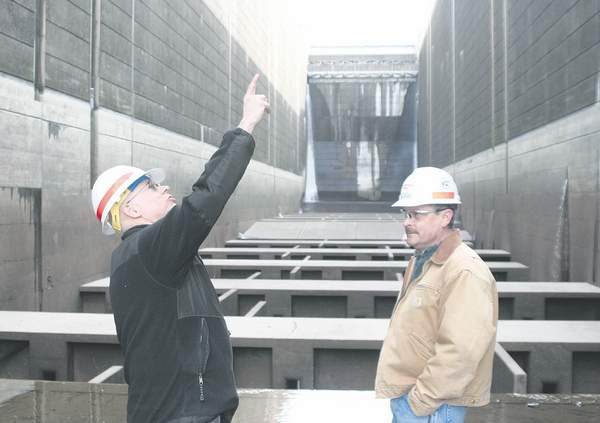forum
library
tutorial
contact

Little Goose Dam Navigation Lock Reopens;
Salmon, Steelhead Barging Begins May 1
by Staff
Columbia Basin Bulletin, April 25, 2014
|
the film forum library tutorial contact |

|
Little Goose Dam Navigation Lock Reopens;
by Staff
|
 Inland commercial navigation between Lewiston, Idaho, and Portland, Ore., resumed at about 4:30 p.m. Monday (4/21/14) with the official reopening of the navigation lock at Little Goose Lock and Dam on the lower Snake River near Starbuck, Wash., U.S. Army Corps of Engineers officials announced.
Inland commercial navigation between Lewiston, Idaho, and Portland, Ore., resumed at about 4:30 p.m. Monday (4/21/14) with the official reopening of the navigation lock at Little Goose Lock and Dam on the lower Snake River near Starbuck, Wash., U.S. Army Corps of Engineers officials announced.
The lock was kept out of service following the annual maintenance outage during March when cracks in the steel of a gudgeon arm assembly on the top of the lock's downstream south gate leaf were tested and determined to be unsafe for continued operation.
Initial emergency-repair schedules estimated a return to service by May 1. Corps project management officials at the Walla Walla District credit past timely maintenance decisions, favorable weather conditions, and exceptional teamwork between Corps and contractor staffs as key components to being able to reopen the lock nine days earlier than originally anticipated.
"First of all, we were fortunate that the developing cracks had already been identified last spring and fabrication of replacement parts had been ordered in September," said Steve Hartman, Corps project manager. "If not for that critical maintenance decision, it could have taken anywhere from 3-4 months just to have the new pieces forged, machined and delivered under an emergency contract."
If Little Goose lock had not reopened for five months, beginning in April 2014, it likely would have interfered with almost 1.5 million tons of commercial shipping. According to district navigation records from April 1 through Aug. 31, 2013 (5 months), 1,441,327 tons of cargo locked passed Little Goose Dam.
Little Goose is located in southeast Washington, just over 70 miles upstream from the Snake's confluence with the Columbia River. The FCRPS includes four Corps-operated dams on the lower Snake River -- Ice Harbor, Lower Monumental, Little Goose and Lower Granite.
Several fish-research projects and the transportation program for juvenile salmon and steelhead would have been impacted if the replacement gudgeon arm assembly parts had not already been ordered.
NOAA Fisheries' 2014 Federal Columbia River Power System supplemental biological opinion calls for fish transportation, which relies heavily upon barging, to typically begin sometime between late-April and May 1.
The BiOp outlines measures NOAA Fisheries believes need to be taken to assure that operations of the FCRPS dams in the Columbia and lower Snake basins avoid jeopardizing the survival of salmon and steelhead that are protected under the Endangered Species Act.
Corps fish managers coordinate with regional fishery experts to be prepared to address the needs of these programs through BiOp adaptive-management processes.
The collection and transportation via barges of some share of migrating juvenile salmon and steelhead is now scheduled to begin May 1.
The BiOp goal is to transport about 50 percent of juvenile steelhead, a species NOAA Fisheries believes benefits most, particularly early in the juvenile fish migration season, from transportation down through lower Snake and Columbia dams and reservoirs.
The BiOp targets a transportation start date at Lower Granite Dam no earlier than April 21 and no later than April 25. NOAA Fisheries analysis has indicated that the transport percentage would be about 48 percent with a May 1 start date.
"The other key to repairing the gate so quickly was the way everyone worked so well together -- design and engineering experts, contracting specialists, maintenance staff, lock operators and the contractor's staff," said Hartman. "Everyone understood the urgency and had a whatever-it-takes attitude and commitment to repairing the gate as quickly as possible."
The Corps awarded an emergency contract on April 1 to Knight Construction of Deer Park, Wash., to install the new gudgeon arm assembly. Contractor workers and Corps staff worked together seamlessly -- staying extended hours, running multiple shifts and performing tasks concurrently whenever possible to minimize the emergency outage period, said Hartman.
"Other than an eight-hour timeframe of strong winds that prevented man basket use, favorable weather conditions really helped out, too," he said.
The Corps provided regular, sometimes daily, updates to commercial navigators, fish managers and other stakeholders, to help them be better able to plan their operations to align with the lock reopening. Commercial vessels bound for up- and down-stream destinations were lined up at Little Goose Lock and Dam for locking service hours as it reopened.
Public Notices and other navigation lock information are available on the Walla Walla District website at www.nww.usace.army.mil/Missions/Navigation.aspx.
Little Goose Dam's navigation lock has a downstream miter gate resembling a giant set of French doors. One gate leaf is about 118 feet tall, 43 feet wide and weighs 334 tons -- from 1986 through 2013, the gate performed 35,713 lockages. A gate gudgeon assembly is a key component of this style of gate, holding the gate into position at the top while the gate pivots to open and close (a hinge-like assembly). The steel gudgeon assembly is an original component of the lock and has not been removed since installation in the late-1960s.
learn more on topics covered in the film
see the video
read the script
learn the songs
discussion forum
